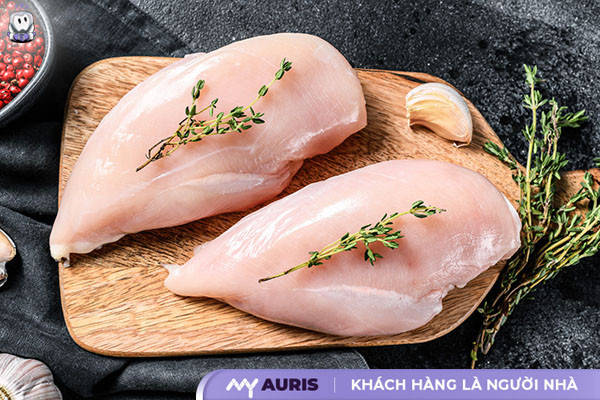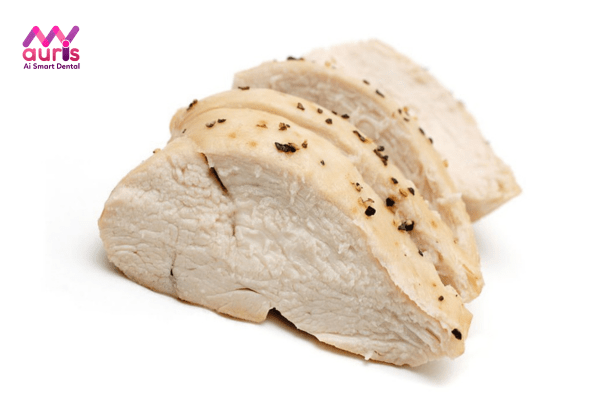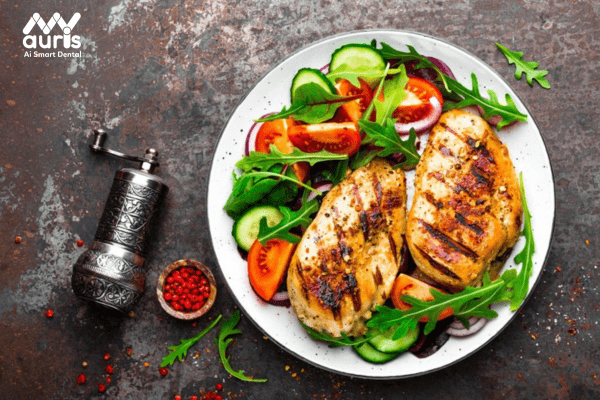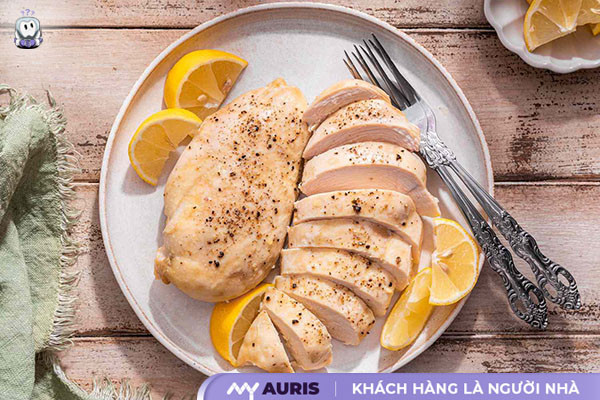On average, 100g of skinless chicken breast contains approximately 165 calories, with protein accounting for 80%, fat 20%, and absolutely no carbs. So, how many calories are in chicken meat, and why is it an ideal choice for weight loss and low-carb diets? Let My Auris find out in detail.
How many calories are in 100g of chicken breast?
In 100g of skinless chicken breast, the average calorie count is around 165 calories – an ideal number for those pursuing a nutrient-rich diet and effective energy control.
- Protein: 31g
- Fat: 3.6g
Analysis shows that approximately 80% of calories come from protein and 20% from fat. Notably, chicken breast contains no carbs, making it highly suitable for low-carb or weight loss diets.
Additionally, the fat content in skinless chicken breast is quite low, primarily consisting of unsaturated fats, with only a small amount of saturated fat, which helps reduce cardiovascular risks.

How many calories are in 300g of chicken breast?
In fact, each 100g serving of skinless chicken breast contains approximately 165 kcal. Therefore, 300g of chicken breast will contain around 495 kcal.
Moreover, this food provides users with many other essential nutrients, detailed per 100g of meat:
– Fat: 3.6g
– Protein: 31g
As can be seen, approximately 80% of the calories come from protein and 20% from fat in chicken breast. At the same time, chicken breast contains no carbs, and skinless chicken breast contains a small amount of fat. It is mainly unsaturated fat with a little saturated fat.
Chicken Drumstick
Chicken drumstick, the lower part of the leg, is a nutrient source rich in protein, low in carbs, and with a moderate amount of fat. In 44g of boneless, skinless chicken drumstick, you will get:
- Chicken drumstick calories: 76 kcal
- Chicken drumstick protein: 12.4g
- Chicken drumstick carbs: 0g
- Chicken drumstick fat: 2.5g
If you consume 100g of chicken drumstick, your body will absorb approximately 172 calories, 28.3g of protein, and 5.7g of fat. Of this, 70% of the calories come from protein and the remaining 30% from fat. This is an ideal choice for those who need to supplement high-quality protein, especially on low-carb diets or healthy weight loss menus.
Chicken Thigh
Chicken thigh is a tender, succulent cut with a distinct rich flavor, more appealing than chicken breast due to its higher fat content. In a 52g serving of cooked boneless, skinless chicken thigh, you will get:
- Calories (chicken thigh): 109
- Protein (chicken thigh): 13.5g
- Carbs (chicken thigh): 0g
- Fat (chicken thigh): 5.7g
Considering 100g of chicken thigh, the specific nutritional breakdown includes:
- 209 calories,
- 26g protein,
- 10.9g fat.
The energy ratio in this cut comes from 53% protein calories and 47% fat calories, helping to balance essential energy and nutrients. Furthermore, chicken thighs are often more affordable than chicken breasts, making them more accessible to consumers while still ensuring meal quality. This is a good choice for everyone, from students and office workers to homemakers looking for ingredients that are both delicious and economical.
Chicken Wing
When considering healthy chicken cuts, many often overlook chicken wings, believing they are not a good choice. In reality, boneless, skinless chicken wings (21g) can still be a healthy option, provided you don’t pair them with high-carb or high-fat foods.
According to nutritional facts, a boneless, skinless chicken wing (21g) contains:
- Chicken wing calories: 42.6 kcal
- Chicken wing protein: 6.4g
- Chicken wing carbs: 0g
- Chicken wing fat: 1.7g
If calculated per 100g of chicken wing, the figures are:
- 203 calories
- 30.5g protein
- 8.1g fat
Of this, approximately 64% of calories come from protein and 36% from fat, helping to effectively balance nutrition.
Chicken Skin
Skinless chicken breast is a popular choice due to its ideal nutritional content of 284 calories, with 80% from protein and only 20% from fat. However, when chicken skin is added, the nutritional profile changes significantly.
One cooked boneless, skin-on chicken breast (196g) provides:
- 76 calories (skin-on chicken breast)
- 12.4g protein (skin-on chicken breast)
- 0g carbs (skin-on chicken breast)
- 2.5g fat (skin-on chicken breast)
Of this, 50% of calories come from protein and 50% from fat (skin-on chicken breast). When consuming chicken skin, you can add an extra 100 calories to your serving each time.
Similarly, a skin-on chicken wing (34g) contains approximately 99 calories, nearly double the 42 calories in a skinless chicken wing. Notably, 60% of calories come from fat (skin-on chicken wing), whereas only 36% of calories in skinless chicken meat (chicken wing) come from fat.
Other Chicken Parts
Besides popular cuts like chicken breast, drumstick, wing, or thigh, you can also choose other chicken parts to diversify your diet. Each cut has its own calorie content, suitable for individual nutritional needs. Below are the estimated calorie counts per 100g for some less commonly mentioned chicken parts:
- Chicken fillet: contains approximately 263 calories per 100g of chicken fillet, rich in protein, and often used in muscle-building diets.
- Chicken back meat: provides 137 calories per 100g of back meat, suitable for grilled or stewed dishes.
- Dark chicken meat: with approximately 125 calories per 100g of dark meat, it has a rich flavor, suitable for braised or fried dishes.
- White chicken meat: lighter with 114 calories per 100g of white meat, often used in weight loss or dieting menus.
Benefits of Chicken Meat
Chicken is a food that provides a lot of protein but is low in fat, making it very suitable for people who are managing their weight or want to limit daily fat intake. Notably, the Omega-3 fats in chicken are beneficial for heart health and it does not contain bad cholesterol like LDL cholesterol or VLDL cholesterol.
Not only rich in protein, chicken is also abundant in vitamins A, E, C, B-group vitamins, along with minerals such as Calcium, Phosphorus, and Iron – all of which play essential roles in maintaining overall health.
The nutritional content of chicken breast is particularly useful in controlling homocysteine levels, a risk factor for cardiovascular diseases. Additionally, natural compounds such as beta-carotene, lycopene, and retinol in chicken help improve eyesight, keeping eyes bright and healthy.
Overall, chicken is an excellent food source, not only rich in nutritional value but also actively supports health care and maintaining physique. It is an ideal choice for a healthy daily diet.

How much chicken should you eat per day for good health?
There is currently no fixed amount for how much chicken to eat per day, as each person has different nutritional needs, activity levels, and metabolic rates. According to nutritionists, adults can consume 140g to 210g of fresh chicken daily to ensure sufficient protein intake for the body.
However, the specific amount of chicken in each meal needs to be flexibly adjusted based on factors such as age, health status, medical conditions, gender, and personal preferences. If your meal already includes many protein-rich foods like pork, beef, or eggs, you should reduce the amount of chicken to avoid excess protein. Conversely, if you have consumed a lot of chicken, reduce other types of meat in your diet.
Eating too much chicken can lead to several concerning health issues such as:
- Increased risk of cardiovascular disease and high blood pressure due to increased blood cholesterol.
- Some studies indicate that excessive chicken consumption may increase the risk of cancer.
- Additionally, eating too much chicken can cause indigestion, constipation, or even diarrhea.
Weight Loss Dishes with Chicken Breast
Although chicken breast is a low-calorie food, it can easily become boring if you don’t know how to prepare new dishes. Diversifying your menu with chicken breast can make it more exciting with the following cooking methods:
Boiled Chicken Breast

Ingredients: 100g chicken breast
Instructions:
- Remove bones and skin, rinse thoroughly, and pat dry.
- Place in a pot, add enough water to cover the meat.
- Boil until cooked, then remove the meat and drain.
Grilled Chicken Breast

- Remove all skin and bones from the chicken breast, use a knife to score diagonal lines on the surface of the meat. This allows necessary spices to penetrate the meat when grilling until cooked.
- Use minced garlic, shallots, and ginger.
- Marinate the chicken in soy sauce, seasoning powder, garlic, shallots, and ginger. Mix well to ensure the spices are absorbed into the meat.
- Marinate the meat for about 30 minutes, then place it on a baking tray lined with aluminum foil. Grill until the meat is cooked through and turns golden brown.
- This meat can be served with various vegetables to make it more appetizing.
Chicken Breast Vegetable Salad

Ingredients: 100g chicken breast, ½ avocado, cherry tomatoes, lettuce, dressing, cucumber, etc.
Preparation:
- Remove bones and skin from chicken breast, boil until cooked, let cool, then shred into small pieces.
- Dice avocado and cucumber.
- Mix the shredded chicken with vegetables, add a little dressing, and you have a delicious weight-loss dish.
Pan-Seared Chicken Breast Vegetable Salad

Ingredients: Cucumber, ¼ pineapple, tomatoes, 200g chicken breast, 1 cup plain yogurt, salt, pepper, honey.
Preparation:
- Chop all vegetables and fruits.
- Rinse chicken, pat dry. Then marinate the chicken with one tablespoon of honey, a pinch of salt, and pepper for 15 minutes.
- To make the dressing: Mix 1 cup plain yogurt with 2 tablespoons mayonnaise, salt, and pepper. Whisk the mixture well to complete the dressing for the dish.
- Pan-sear the chicken breast until evenly cooked. Add a little salt and pepper for extra flavor (note: do not add too much).
- Mix the chicken breast with the prepared vegetable dressing to complete the dish.

How to Cook Chicken Best?
Chicken is known to be much lower in calories and fat than red meats. However, when preparing food by adding oil, sauces, batter, or breading, the calorie content of the dish can increase significantly.
For instance, 100g of ginger-braised chicken or 100g of stir-fried chicken with lemongrass and chili contains approximately 175 calories. Meanwhile, 52g of cooked boneless, skinless chicken thigh provides 109 calories and contains 5.7g of fat. But when fried with a batter coating, fried chicken will have up to 144 calories and 8.6g of fat. Furthermore, if the chicken thigh is fried with a flour coating, the energy increases to 162 calories along with 9.3g of fat.
Similarly, 21g of boneless, skinless chicken wing has only 43 calories and 1.7g of fat, but when the chicken wing is coated in sauce, the energy increases to 61 calories and 3.7g of fat. If the chicken wing is fried with batter, the calorie content remains at 61 calories, but the fat slightly increases to 4.2g.
Therefore, to keep calorie intake low and maintain the healthiness of low-calorie, low-fat chicken, you should prioritize low-fat cooking methods such as boiling, stir-frying, or steaming. This is the best way to cook chicken to preserve its nutritional value without adding unnecessary energy.





